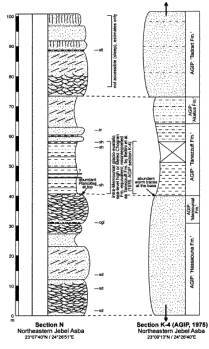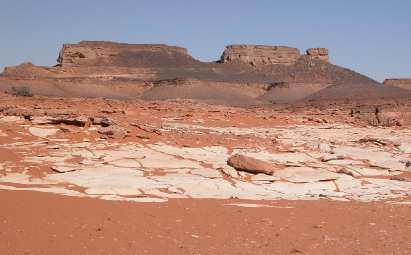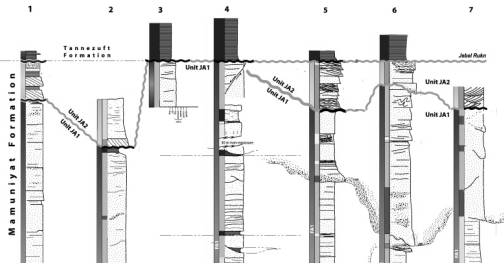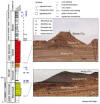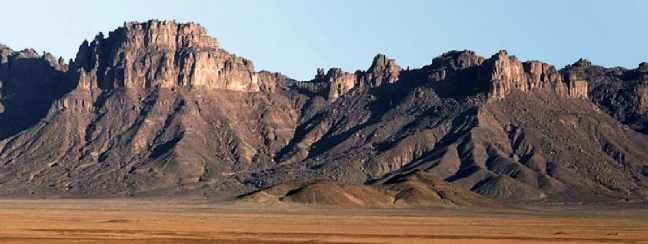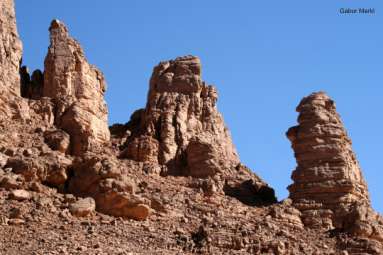|
In the Upper
Ordovician Mamuniyat Formation fine and medium sandstones, numerous levels
of conglomerate are present. Beds with Tigillites have been observed. Metamorphic
sandstones have been observed at Jabal Qardah (30 km west of Jabal
Arkenu). Another small outcrop of metamorphic quartzites, more or less bedded,
is located 12 km N of Jabal al Qardah, corresponding with a fault running
approximately SE-NW. The age of these metamorphic sandstones is uncertain.
To the west of these last two reliefs, some scattered outcrops of the basement
-- both metamorphic and granitic -- are overlain by well-layered sandstones
which are generally medium and fine grained and reddish on the surface. A
level was discovered with frequent Tigillites. Approximately 4 km further
west, amongst the sandstone, siltstone levels appear in which it is sometimes
possible to observe frequent and notably developed Arthrophycus (Harlania)
sp.
The same Situation is to be found, well exposed in a relief, 2 800 km long
in a N-S direction and located 20 km WNW of Jabal Qardah. At the base, in
the southern zone of the relief, sandstones are present both well-layered
or very thick-bedded and pale in colour, which show a marked glacial morphology.
On this eroded, "moutonnee" surface, there are deposits of darker, more cemented,
medium- and coarse-grained and often cross-bedded, sandstones. More silty
levels, soft at the base, sometimes contain abundant, long Arthrophycus.
These upper sandstones are more than 40 m thick. In the northern part of this
relief, volcanic rocks of a basaltic type have intruded along a NW-SE fracture.
Phenomena of contact metamorphism between sandstones and basalt are quite
limited. The age of the basaltic intrusions is Oligocene.
The whole region W and N of this relief, for a depth of 10-12 km is occupied
by hundreds of pinnacles and conical hills of coarse- to fine-grained sandstones;
these are generally pale or whitish at the ase, often cross-bedded, more or
less cemented and typically oneycomb-shaped from wind erosion. These sandstones
underlie the shales of the Tanezzuft Formation and outcrop in a NE-SW alignment
(section 10). In
the Jabal Asba area the Ordovician is present
in various outcrops.
The characteristic morphology of very high pinnacles and blades is the result
both of a NW-SE System of fractures and of marked wind and glacial-type erosion.
Layered sandstones (Mamuniyat Formation) follow, often with parallel laminations,
fine- and medium-grained, from buff to violet, with some harder levels rich
in ferruginous cement, but generally slightly cemented. In the central western
zone of Jabal Asba, the section 4
shows 64 m of Ordovician sandstones. The lower 57 m are represented by thick
beds of sandstones, fine- to coarse-grained, generally with parallel lamination.
The top of these sandstones shows a morphology characterized by large pinnacles
and blades directed NW-SE, rounded peaks and U-shaped valleys. Unconformably,
and with a fine conglomerate at the base, approximately 7 m of buff-brown
to reddish sandstone follow, medium- to coarse-grained, with clear cross-bedding,
which fill all the eroded parts of the underlying formation and are overlain
by the shales of the Tanezzuft Formation. These sandstones must be considered
as belonging to the Upper Ordovician Mamuniyat Formation.
Similar sandstones of the Mamuniyat Formations were
found in the NE area of Jabal Asba (section 13).
Sometimes there are beds with abundant and large fossil (bioturbations)
traces. Sandstones of the Mamuniyat Formation were found in the KW2 and KW3
shallow wells below the Tanezzuft shales.
* The original text has been changed:
The feigned high sandstone wall in Jabal Arkenu is not Cambrian Hassaouna
formation (see appendix)
Two formations were
recognized, Tanezzuft and Akakus, which are typical in the Silurian of the
surrounding Palaeozoic basins. The Tanezzuft shales have been described as
being up to 130 m thick in outcrops at the basin margins, but the shales were
found to be replaced by siltstones and sandstones in two dry exploration wells
drilled in the northern part of the basin by AGIP between 1978 and 1981.
Tanezzuft Formation (Lower Silurian).
In the Jabal Asba, the Tanezzuft Formation outcrops over large extensions.
In the SW area of this relief, the section
2 has shown 40-50 m of greenish and
grey shales, sometimes, on the surface, whitish or purple, very thinly layered,
soft, often with coating and dendrites of manganese, and with some interbeddings
of greyish, hard micaceous siltstone.
Some graptolites of the species Climacograptus medius (TORNQUIST)
were found. The Chitinozoa assemblage from 27-33 m consists Ancyrochitina.
According to the graptolites the interval from 18-31 m belongs to Lower Llandovery.
In core 36-37 m most of the Chitinozoa are absent and the assemblage is dominated
by the species Conochitina chydaea JENKINS in association with Rhabdochitina
cf. magna EISENACK and Lagenochitina sp.; these species suggest
an Upper Ordovician age (Caradocian-Ashgillian). In the same cores, traces
of small Pelecypoda and carbonaceous matter were found. The depositional
environment of this formation is open marine and its thickness in the central
and northern areas of Jabal Asba is 24 and 18.5 m respectively. At the base,
in contact with the sandstones of the Ordovician Mamoniyat Formation, a thin
level was observed with abundant traces due, in all probability, to worms.
This characteristic level was commonly observed at the Tanezzuft-Mamoniyat
boundary.
Akakus Formation (Lower-Middle Silurian).
In the area this formation is well characterized from the lithologic and palaeontologic
point of view, but it shows very limited thicknesses everywhere. Region of
Jabal Qardah (section 10):
25 m of dark grey and grey-green, flaggy siltstone, with thin interbeddings
of fine-grained, cemented sandstone and micaceous shales. Rare indeterminable
fossil traces were observed on some surfaces. It is thought that the highest
part of this formation is eroded, due to the absence of Arthrophycus and Cruziana
beds, generally widespread in the whole region, and of the Tadrart sandstones;
in this section the Akakus Formation is unconformably overlain by the Middle-Upper
Devonian Binem Formation. Southern part of Jabal Asba
(section 2):
this formation is represented by only 2-5 m of siltstone and fine-grained
sandstone, greenish-grey to reddish, with some interbeddings of silty-micaceous
shales. In the highest part there is a siltstone bed, hard, yellow and very
heavy with characteristic stromatolitic structure. This is a very widespread
level in the highest part of the Akakus Formation in this region. There are
extremely abundant sedimentary structures (ripple marks, flute casts, etc.)
and also fossil traces (Cruziana furcifera, Arthrophycus sp., etc.).
The boundary with the underlying Tanezzuft Formation is rather gradual, whilst
it is very sharp, marked even with a base conglomerate, with the overlying
Tadrart Formation. Central part of Jabal Asba
(section 4):
9 m of siltstones and silty-micaceous, multicoloured shales, giving way to
fine-grained, cemented sandstones. Abundant sedimentary structures (flute
casts, ripple marks, etc.), bioturbations and fossil remains including numerous
Arthrophycus sp. and Cruziana sp. were observed. A similar
sequence, 5 m thick, was found in the
section 13
both from the lithological-sedimentological and the paleontological point
of view.
The dominantly continental
sandstones of the Lower Devonian, locally with shale interbeddings, have been
referred to an undifferentiated complex of the Tadrart Formation; the
overlying, dominantly marine, sandstones and shales have been referred to
the Binem Formation.
Tadrart Formation (Lower Devonian)
In the southern region, in the Jabal Qardah, this formation may be
completely absent, as has been observed (section
10) where the Akakus Formation is directly
overlain by the Zoophycus sanstones of the Binem Formation. Differently the
northern part. In the section 2
of Jabal Asba: 62 m of
light nut-brown to grey-violet, fine to extremely coarse grained sandstones
with thin and irregular beds of fine conglomerate; a conglomerate bed is present
at the base, at the contact with the Akakus Formation. In general this is
a very porous sandstone, slightly cemented and medium to very thick bedded;
some thinner levels are of dark, hard ironstone. Sedimentary structures are
represented by cross-beddings, foresets, laminations and slumping phenomena.
In some cases there are well developed phenomena of overturned cross-bedding
or very dipping beds of sandstones and gravels, probably due to fluvial or
dune deposits. Central part of Jabal Asba (section
4): 53 m of fine to very coarse grained
sandstones, sometimes with irregular beds or lenses of fine conglomerate,
with some thin (l 5-20 cm) very irregular interbeddings of siltstones and
greenish-greysilty shales. The sandstones are generally very thick bedded
and with cross-beddings, overturned cross-beddings, foresets, parallel and
cross-laminations, slumpings, etc. In this sequence there are also dark, hard
beds with abundant ferruginous cement; one of these beds, 30-40 cm thick,
marks the boundary with the overlying Binem Formation. In the
section 13
the thickness of the Tadrart is 41 m. The beds of siltstones and silty shales
are more numerous and thicker compared with the above-mentioned sections.
There are thick beds of red and violet-red hard sandstone, with ferruginous
cement, such as usually marks the boundary of this formation with the Binem.
Binem Formation (Middle-Upper Devonian).
The Binem Formation has never been formally described and published. The
type section is located in the Tibesti area, probably in the area of Wadi
Binem-Wadi Ounga. Another suggested reference section in Libya is represented
by coordinates 21�52'08"N and 19�44'10"E.
In the Jabal Qardah (section
10), the greatest thickness of Binem
Formation was measured (160 m). As already stated for this section the Akakus
is unconformably overlain by multicoloured (whitish, pale grey, purple, etc.),
fine-grained sandstones, generally cemented, with some very thin beds of reddish
hard siltstone, with ferruginous cement and sometimes with abundant Zoophycus.
At the top, the section is formed of sandstones as above, sometimes only slightly
cemented, with some interbeddings of siltstone and silty shales and thin beds,
or crusts, of hard, red-purple siltstones. Beds with abundant Zoophycus
(their size varying from a few cm up to 20 cm) and a few other fossil traces
are common. A wide sandy plain separates the top of this formation from the
first outcrops of Continental Mesozoic.
Another outcrop of Binem sandstones lies 20 km N of Jabal Qardah (section
9); 31 m are exposed but it was not
possible to see the lower and upper boundaries of the formation. At Jabal
Asba this formation is well exposed and more complete. In the southern
part (section 3)
a thickness of 35 m was measured, represented by pale grey and purple sandstones,
often brownish-red or brick red on the surface, from fine- to medium-grained,
well layered, often with cross-beddings, sometimes passing to very slightly
cemented siltstone. Rare indeterminable fossil traces were observed.
Section 5:
22 m of whitish, pale grey, fine to very fine grained, more or less cemented
sandstones with some thin interbeddings of whitish siltstone or very hard
reddish clay. Zoophycus of varying size are distributed at various
levels throughout the section. Section
4: 45 m of brown-red, reddish, purple
and greyish sandstones with grains ranging from medium-fine to coarse, generally
well layered, with some harder levels cemented by iron minerals.
Section 6:
52 m were measured, 22 m of which are fine, pale grey and purple, well-layered
sandstone, with frequent Zoophycus and 30 m are red-brown and buff-brown
sandstones, fine- to coarse-grained, often cross-bedded, rarely with fossil
traces. In the section 13
the thickness of the Binem is 56 m. The upper part of several sections show
thick-bedded sandstones with common vertical, parallel burrows (cf. Tigillites).
The sandstone outcropping in the W and NW areas of Jabal Asba is to
be added to the Binem Formation. These sandstones are fine-grained, buff,
whitish, pale grey, sometimes purple, porous, only slightly cemented. They
are often thinly bedded, with common interbeddings of whitish flaggy siltstone.
Morphologically they are similar to the sandstones of the upper member and
may contain rare fossil remains, including Zoophycus. In the
section 7
these sandstones have a thickness of 47 m; of remarkable interest is the presence,
at the base of the section, of fine, whitish, crumbly sandstones with very
common traces and remains of plants (even longer than l m) at
longitude 24�23'38" and latitude 23�15' 25". At the top of the section there
are, again, rare Zoophycus sp. and other organic traces.
The Binem Formation outcrops NE of southern Jabal Asba show numerous sandstone-siltstone
beds with Bifungites fezzanensis DESIO common. Extremely extended outcrops
of the Binem, particularly the Zoophycus sandstones, are located in the most
northern area of Jabal Asba and on the SW side of Jabal Rukn.
Around Jabal Asba
the sediments of the Middle-Upper Devonian are unconformably overlain, towards
the W, by continental Mesozoic, while, immediately to the N of lat 23�30'
N, they are overlain by sequences of Carboniferous sandstones.
On account of their lithological, sedimentological, palaeontological and
environmental characteristics they were referred to the Dalma Formation (from
the high hill of Jabal Dalma (Zalmah), NNE of Kufra with coordinates: 25�34'10"N
and 23�55'15"E).
Two sections were measured and sampled in this formation. The first
section 11
shows 95 m of buff-brown, greenish-yellow to grey-purple sandstones, mainly
medium and fine grained, sometimes even coarse-grained in the lower third,
well-bedded (with common cross-beddings), generally hard and cemented in the
higher part, more crumbly in the lower part. In the higher part the sandstones
are sometimes very fine grained, thinly bedded and with numerous traces of
bioturbations or other indeterminable fossil traces. In the central part of
the section, plant remains, including probable roots, have been observed.
Further below there are traces and small trunks of plants
belonging to the Licopodophyta and again some beds with common traces
of "roots". These have been completely replaced by sandstone. About 10 m from
the base of the section, large concretions of fine sandstone are common; these
are well cemented (sometimes quartzites), long and nearly cylindrical in shape
(up to more than 2 m); the size and shape of most of these concretions recall
trees completely replaced by sandstone. This characteristic level is to be
found for several kilometres in the area W of this place. The
section 12
has shown 205 m of Carboniferous sediments; it was made in a group of hills,
a synclinal fold, located immediately N of outcrops in the Binem. At the base
the outcrops are represented by more than 45 m of fine-grained sandstones,
with some thin levels or lenses of conglomerate, generally only slightly cemented
on the surface, which form steep and almost inaccessible walls. These are
followed by 5 m of whitish-grey, very thinly bedded, quite soft siltstone
with numerous plant moulds (Licopodophyta). Subsequently there are
fine- and medium-grained sandstones, varying in colour from pale grey to purple,
generally only very slightly cemented, thick-bedded in the lower part and
subsequently more thinly bedded and with some siltstone beds. There are small
irregular beds of conglomerate, cross-beddings, foresets, parallel and cross-laminations.
Remains and moulds of plants (Licopodophyta) were observed in the lower
part. A further 21 m of fine sandstones and siltstones follow, more or less
clayey, thinly bedded and multicoloured with common bioturbations and rare
specimens of large Bifungites sp. (5-6 cm in size).
The upper part of the section is represented by sandstones, coarse- to fine-grained,
sometimes with irregular beds of fine conglomerate, generally only slightly
cemented, harder in the higher part, with some levels of clayey and flaggy
siltstone. Numerous beds have provided various moulds and remains of plants
(Licopodophyta) and of roots; bioturbations occur locally. This sequence
is unconformably overlain by the Continental Mesozoic.
|



